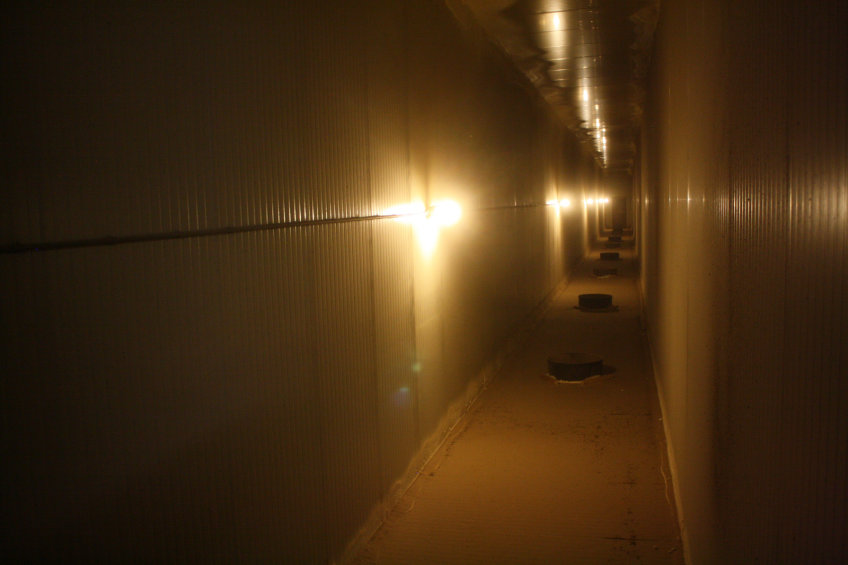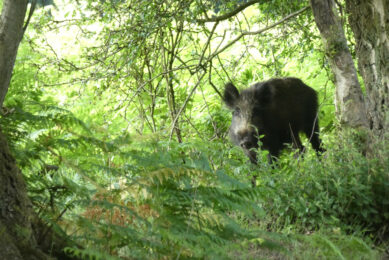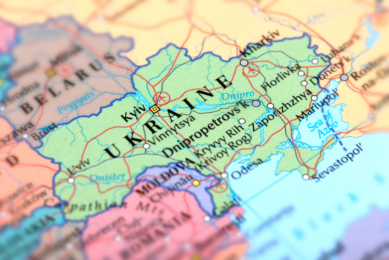There’s money in pig house air

The Netherlands has advanced far with capturing odorous substances from outgoing air from pig houses. The next objective is to also capture outgoing heat. This can prove to bring in substantial amounts of money for pork producers.
The door does not open easily, it is like somebody is pulling on the other side of the door. Once inside the room, all kinds of noise make it hardly possible to talk. To the right a lot of brownish water is falling through a platform, to the left a rapidly rotating fan blows wind in – behind it a long corridor. It is hard to believe all this is happening right on top of a pig farm.
Yet it is. The room is the centre piece of an air scrubber system at the Clephas-Jacobs farm, near the village of Veulen, in the south of the Netherlands. In this area, cleaning outgoing air from farm houses is desirable if not even mandatory, as neighbours or a protected zone of natural interest are never far off. And it’s not only the Netherlands where air scrubbing is wanted. In surrounding countries like Germany, Belgium and Denmark, air scrubbing is part of the game these days.
Available as add-on compartments, but often integrated in pig (or poultry) houses, air scrubbers aim to treat outgoing air with water going into an opposite direction. By ways of absorption, elements like dust, odour and ammonia are being filtered out of the air. Scrubbers, usually positioned behind a pig house – or even on top of it – come with closed water circuits and pumping systems; they can be chemical, using sulphuric acid, or biological; and they require a sophisticated climate control system as well as regular maintenance.
Bottom line: Having an air scrubber installed requires a substantial investment, often tens of thousands of euros. Benefits for pork producers, however, are usually relatively limited. Simply being allowed to stay in business is what they get in return – as well as having happier neighbours. No wonder air scrubbers are mostly seen as equipment that costs money. This is where the approach at Clephas-Jacobs farm is different – a reason for Pig Progress to take a closer look.
Re-using energy
Key to the approach at the Clephas-Jacobs farm is that the air scrubber has an extra which ensures the re-use of energy.
Used air, on its way out from a pig house, contains a considerable temperature of about 20-22°C, explains Maurice Vleugels, manager sales and service at climate control company Stienen BE. He adds, “This heat energy can partly be re-used. In winter, outgoing air is warm as we have been heating inside the pig houses. But don’t forget the pigs themselves also produce heat. It would be a waste if we would just send this heat energy out and do nothing with it.”
Ron Kleuskens, sales representative at Inno+, an engineering company specialised in the construction of air scrubbers, supports this explanation with a quick calculation: “A pig of 23 kg would produce heat of 42 Watt; finisher pigs of 110 kg even produce 127 Watt; a lactating sow usually produces 375 Watt and a gestating sow produces 200 Watt. So a pig house having 3,500 finisher pigs would in total generate 313 kW, whereas a sow house having 500 sows may generate 185 kW.”
Re-using energy may in itself not be a revolutionary idea. Making a transition from complex to simple is why it has taken some time to devise a system like this, Vleugels emphasises. Understanding air flow in a pig house is a multifactorial balancing act involving physics, chemistry and biology – but what a pork producer needs is an easy-to-operate system that he hardly has to worry about. It is here where his company Stienen BE and Inno+ found each other. Jointly, they were responsible for setting up the strategy described above, and called it ‘Triple EEE Concept’. Its name loosely refers to ‘Triple A’, a term used in the world of banking. In this case, the three E’s refer to ‘Economy, Efficiency and Energy’.
Energy
What does this imply for the system in the Clephas-Jacobs farm? As described, air is drawn from the pig rooms below through the ceiling into a central exhaust system near the roof. The air enters the central air scrubbing room as described through a high pressure fan. The air is then drawn from below through the platform, where the water falls through for absorption. So far it is a fairly common situation – the difference is made by the presence of a heat exchanger, positioned inside the air scrubber. It consists of a large screen of dense plastic tubes, filled with a mixture of water and glycol – this cannot freeze easily but which can absorb the heat.
This heat exchanger absorbs some of the outgoing air’s relative heat in winter and some of its relative cool temperatures in summer. In turn, the heat exchanger is connected to a separate farmwide circuit, including more heat exchangers. Where the one described is treating outgoing air, the others are located at the place where incoming air comes in – at the air inlets, also see Figure 1.
These inlets are located partly hidden in the ground, and come out on a passage underneath the farm building. New air, after having been drawn in, is warmed up or cooled down by the heat exchanger – the system guarantees fresh air entering the building at a minimum of 8°C. The air will be mixed with already present air in the corridor, after which it gradually flows into the farm building at a temperature as steady as possible.
Consistency
Thus consistency is created – and exactly that is what also benefits the animals, explains Kleuskens. “In theory, the animals can deal with high temperatures, no problem, if only the temperature doesn’t change all the time. The animals do very well if only temperatures are constant,” he says. In summer in the Netherlands, temperatures can rise up to 30°C; in winter, temperatures can be as low as -10°C.
Not only the incoming air benefits from the heat exchanging system at the farm.
A second destination for the energy absorbed in the Clephas-Jacobs farm is a heating system in the farrowing house. Submerged into the solid floor of the farrowing house are tubes to heat the piglet nest – as piglets benefit from a bit of extra warmth. This system is driven by a central heat pump, which warms the water until it is about 45 or 50°C. Supplying the already pre-heated water to the heat pump saves a substantial amount of money, explains Vleugels.
The piglets at the farm do benefit from these warm piglet nests longer than only the farrowing period. After weaning, owner and pork producer, Hans Jacobs simply removes the sows and the crates.
Total energy costs
Kleuskens states that the Triple EEE Concept can save up to 80% of total energy costs for pig houses. Jacobs can only say that the initial months have rendered him more than happy.
He had the total system applied in September 2012. After the first eight months of the system being in operation, his total energy costs for this barn were €124, while last year’s winter has been unusually long in most parts of Western Europe. Not a bad score, considering that an average household pays €100 per month.
Ron Kleuskens, Inno+: “The pigs do very well if only temperatures are constant.”
Clephas-Jacobs farm, the Netherlands
Farm type: Multi-site farrow-to-finish farm + 50 ha regular crop cultivation, including iceberg lettuce.
Total number of sows: 670.
Total finisher pig capacity: 2,800.
Piglet transfer at: 23 kg.
Breed: Topigs 40 x Pietrain.
Piglets/sow/year: 28-29.
Remarkable: Triple EEE concept is applied in one sow house, added in 2012 to the breeding location. This house has 352 combined farrowing and nursery places, in 11 compartments. The piglets stay here until 23 kg.











